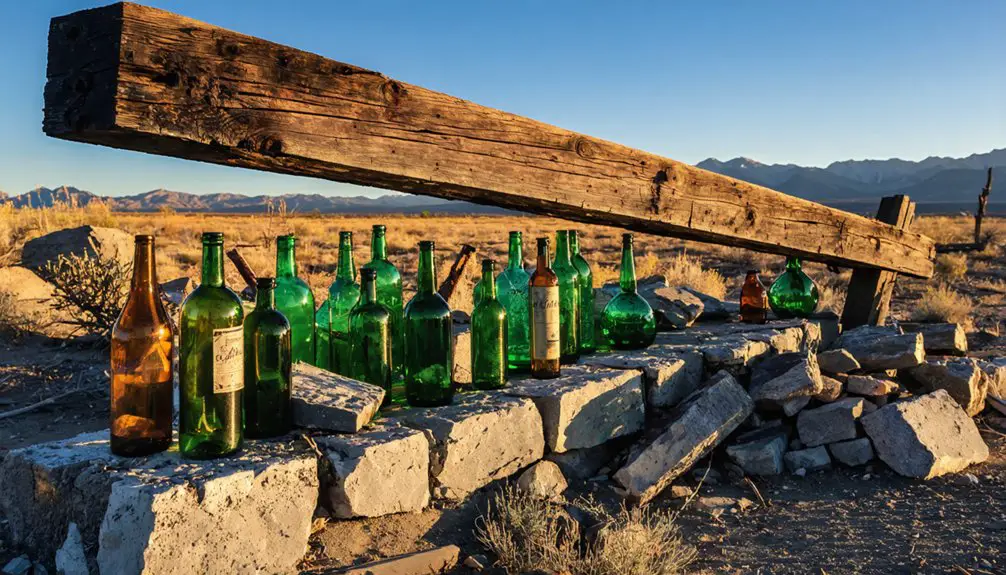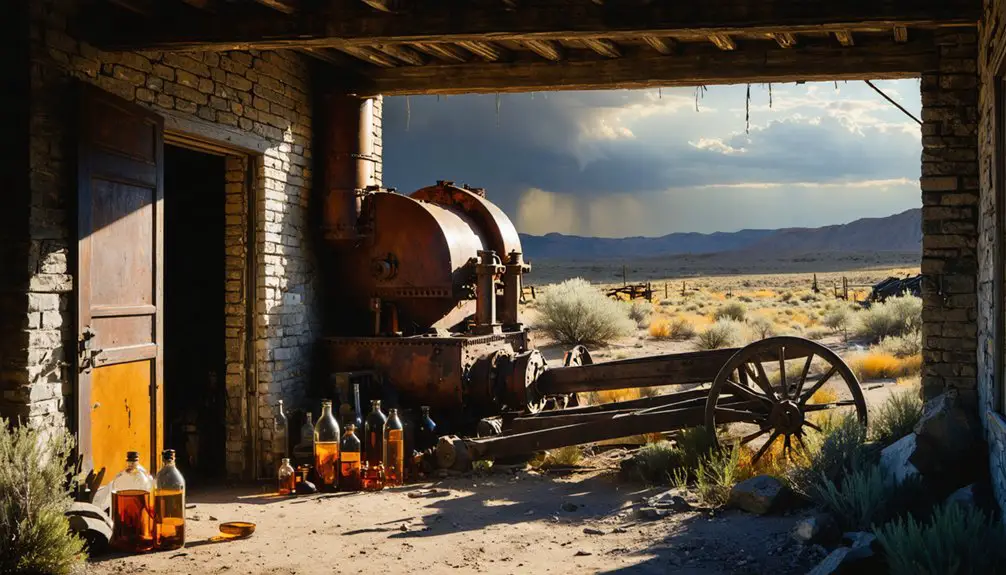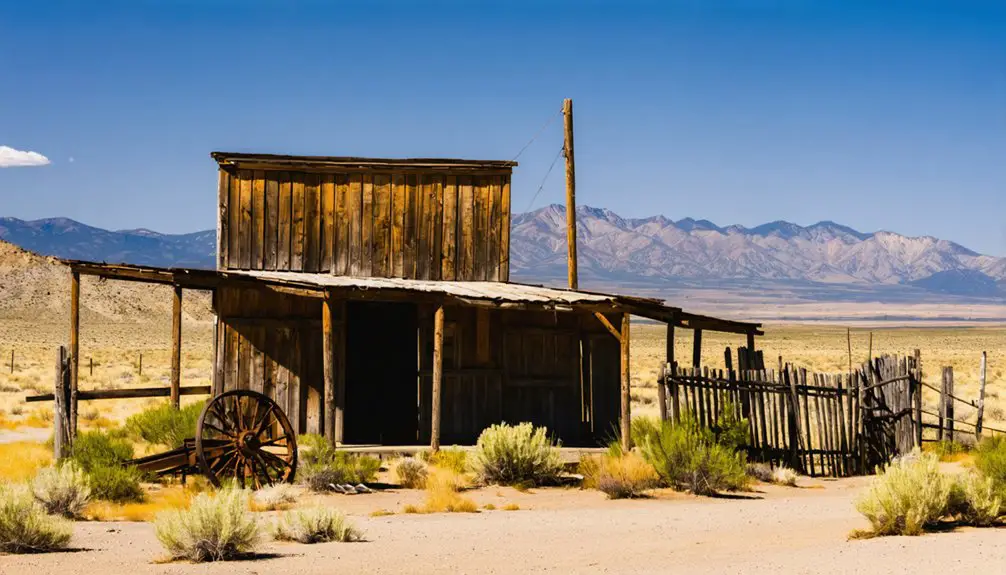You’ll find Horse Heaven ghost town east of Ashwood in Jefferson County, Oregon, where rich cinnabar deposits were discovered in the early 1900s. The site flourished between 1934-1944 as a mercury mining operation, producing over 17,000 flasks from its ten-level underground network. A devastating fire in 1944 and subsequent mine collapses led to its permanent closure by 1958. Today, you can explore the 40-acre site’s massive tailings, sealed adits, and historic mining structures that tell a compelling story of Oregon’s mercury rush.
Key Takeaways
- Horse Heaven was a thriving mercury mining community in Jefferson County, Oregon, operating from 1934 to 1958.
- The ghost town’s main operation produced 17,214 flasks of mercury through a sophisticated ore processing system and ten mining levels.
- A devastating fire in 1944 destroyed key structures, leading to initial closure in 1945 and final abandonment in 1958.
- Today, visitors can see massive tailings piles, sealed mine entrances, original mining equipment, and a 300-foot vertical shaft.
- The site spans 40 acres and once supported about 100 residents living in seasonal cabins during its peak in the 1930s.
The Discovery That Started It All
While Oregon’s mining history is rich with tales of gold and silver, it was the discovery of mercury deposits in the early 1900s that put Horse Heaven on the map.
You’ll find this historic site east of Ashwood in Jefferson County, where early prospector motivations centered on the region’s promising quicksilver deposits. The initial discovery emerged from geological surveys that identified significant cinnabar ore formations in the area’s fault zones and mineralized host rock.
Deep in Jefferson County lies Horse Heaven, where rich cinnabar deposits once drew prospectors seeking their fortunes in quicksilver mining.
Unlike nearby settlements focused on logging or farming, Horse Heaven’s isolated location made it perfectly suited for mining development. The discovery sparked rapid growth, with mining companies quickly establishing infrastructure including vertical shafts, adits, and processing facilities. Similar to Auburn’s gold rush, Horse Heaven’s mercury discoveries brought an influx of eager prospectors to eastern Oregon.
Soon, a bustling mining camp emerged, eventually growing to support nearly 100 residents. The site exemplifies the many mining towns and camps that dotted Oregon’s landscape during its resource extraction heyday.
Mercury Mining Operations and Peak Production
You’ll find that Horse Heaven’s mercury mining peaked between 1934-1944, when the operation processed cinnabar ore through its Herreshoff furnace to produce 15,097 flasks of mercury.
The mine’s processing methods evolved from this initial Herreshoff system to include a 30-ton rotary furnace plant during its 1955-1958 revival phase.
The site spans 40 acres in Jefferson County and includes both historic mining structures and a seasonal residential cabin. The underground operation consisted of ten mining levels with multiple sub-levels throughout the workings.
Peak Production Years
After the discovery of cinnabar in 1933, Horse Heaven Mine quickly developed into a notable mercury producer, reaching its peak operational years between 1934 and the early 1940s.
You’ll find that initial production from the Number One level yielded 2,200 flasks within just two years, demonstrating the mine’s economic impact.
When Sun Oil Company acquired the operation in 1936, production accelerated considerably, reaching 15,097 flasks by 1944.
Despite environmental concerns, the mine’s strategic location near volcanic plugs of biotite rhyolite enabled efficient extraction of rich cinnabar deposits.
Similar to other mines in the Ochoco National Forest, cinnabar was processed to extract mercury for use in gold and silver mining operations.
The Department of Environmental Quality now oversees the area as a superfund site due to contamination concerns.
The mine’s success continued until a devastating fire in 1944 damaged the furnace and power plant.
Though operations briefly resumed from 1955 to 1958, adding another 2,000 flasks, the mine never recaptured its early peak production levels.
Mine Processing Methods
The Horse Heaven Mine’s processing operations centered on a sophisticated mercury extraction system designed to handle cinnabar-rich ore bodies found in the volcanic breccia zones.
The processing workflow involved crushing raw ore and storing it in bins before feeding it into the facility’s rotary furnace, which was installed in 1955.
You’d find the mercury processing technique relied on heating cinnabar ore to volatilize the mercury, followed by condensation to collect liquid quicksilver.
The operation, though small in scale, included essential equipment like crushers and conveyors to maintain consistent ore feed rates.
While processing continued intermittently through 1957, the facility faced challenges with varying ore grades, averaging around 6 pounds of mercury per ton.
The remote location and mechanical maintenance needs added complexity to the operation’s daily workflow.
Mercury Output Statistics
Horse Heaven Mine’s mercury production spanned multiple operational phases, yielding a total of 17,214 flasks by its closure in 1958.
You’ll find the mine’s most productive period occurred between 1934-1944, when mercury extraction techniques generated 15,097 flasks before a devastating fire halted operations.
After a brief cleanup effort in 1945 that recovered 74 flasks, the mine lay dormant for a decade.
Production challenges arose when operations resumed from 1955-1958, though a new 30-ton rotary furnace helped process an additional 2,040 flasks from approximately 18,829 tons of ore.
The nearby Axe Handle mine contributed 150 flasks to the district’s total output.
Mining focused on high-grade breccia zones containing cinnabar, averaging 6 pounds of mercury per ton.
The mine was a significant part of the Horse Heaven Mining District in Jefferson County, Oregon, where several mercury deposits were discovered.
Life in a Mining Boomtown
In Horse Heaven’s bustling 1930s heyday, you’d find around 100 residents living in seasonal cabins near the mine site, with their daily lives revolving around the demanding work of mercury extraction.
You’d see miners spending long days performing physically intensive underground work, operating furnaces, and processing cinnabar ore into liquid mercury. The mild climate and low altitude terrain made working conditions more favorable compared to other mining regions in Oregon. Mercury mining operations were the primary economic driver that sustained the community during its peak years.
The close-knit mining community‘s social bonds formed naturally through shared work experiences, though amenities remained limited due to the town’s remote location and small size.
Daily Mining Life Realities
While cinnabar mining at Horse Heaven promised economic opportunity, daily life for miners involved grueling physical labor and constant hazards from 1933 to 1958.
You’d spend long shifts underground drilling through rock, hauling ore, and operating dangerous machinery with minimal worker safety standards. The risks you’d face included cave-ins, toxic mercury vapors, and fires – as proven by the devastating 1944 blaze that halted operations.
Your work environment centered around deep vertical shafts reaching 300 feet and a maze of drifting tunnels.
You’d operate between early Herreshoff furnaces and later 30-ton rotary furnaces, processing cinnabar into quicksilver while enduring dust and fumes.
Living conditions weren’t much better, with basic seasonal cabins serving as home near the mine’s constant activity.
Community and Social Bonds
Despite its remote location in rural Oregon, the cinnabar mining community at Horse Heaven developed distinct social bonds from 1933 onwards.
You’d find community resilience through shared experiences at the mine, where workers forged social networks that helped them survive the harsh realities of boomtown life.
Key aspects of Horse Heaven’s community bonds included:
- Informal gathering spaces in boarding houses and company-provided facilities
- Knowledge sharing between miners for safety and productivity
- Mutual aid networks during emergencies and resource shortages
- Connections maintained with nearby towns through trade and supply chains
Though mainly male and transient, the workforce created lasting bonds through their shared mining culture.
Even seasonal residents participated in the tight-knit community, contributing to Horse Heaven’s social fabric until its final closure in 1958.
After cinnabar was discovered in 1933, the rapid establishment of mining operations brought an influx of workers seeking opportunity.
The Fire of 1944 and Its Aftermath

A devastating fire swept through Horse Heaven in 1944, destroying the ore-processing furnace, power plant, and several essential structures that supported the town’s mercury mining operations.
The fire aftermath forced the mine’s closure in 1945, disrupting the economic lifeline of this Oregon mining community.
When fire halted Horse Heaven’s mining operations in 1945, it severed the economic artery that kept this Oregon community alive.
While attempts were made to revive operations with a new furnace in 1955, significant mine collapses between 1955 and 1958 further weakened the infrastructure.
The combination of operational challenges and declining mercury demand led to the mine’s permanent closure in 1958.
The community decline was swift and irreversible – businesses shuttered, residents departed, and the once-thriving mining town transformed into a ghost town.
Today, you’ll find only gated mine entries, extensive tailings, and preserved machinery as evidence of Horse Heaven’s mining legacy.
Geological Treasures of Horse Heaven Mountain
The geological foundations of Horse Heaven Mountain tell a story far older than its mining history.
You’ll find remnants of ancient Eocene volcanic activity in the form of the Clarno formation, where volcanic necks and dikes pierce through the landscape. These geological formations were later shaped by the massive Columbia River Basalt flows and intense tectonic forces that created the distinctive anticlinal ridge structure you see today.
- Volcanic deposits include andesites, tuffs, and tuffaceous sediments
- Ancient metamorphic rocks appear as xenoliths within volcanic materials
- Columbia River Basalt Group forms the primary bedrock structure
- Volcanic ash from Cascade eruptions contributes to unique soil composition
During the Pleistocene epoch, the Missoula Floods transformed the region, leaving behind glacial erratics and erosional features that you can still spot along the mountain’s northern slopes.
Legacy of the Quicksilver Rush

Quicksilver mining transformed Horse Heaven‘s landscape in 1934 when R.R. Whiting initiated the first productive adit into cinnabar-rich rhyolite.
You’ll find traces of this quicksilver heritage in the remaining mine workings and equipment that dot Horse Heaven Mountain’s northern base, where miners once extracted 76-pound flasks of mercury from the depths.
The rush’s impact rippled through Jefferson County, creating jobs and infrastructure that shaped Oregon’s mining economy.
Horse Heaven Mines, Inc.’s operations expanded until 1944, reaching depths of 350 feet while using state-of-the-art Herreshoff furnaces.
Today, mining nostalgia draws visitors to this historic district, where altered rhyolite ledges and abandoned tunnels tell the story of a once-bustling mercury mining community that helped power the region’s industrial growth.
Exploring the Ghost Town Today
Modern visitors to Horse Heaven ghost town encounter a landscape dominated by stark reminders of its mining past, including massive tailings piles, an imposing open pit mine, and weathered head-frames that pierce the skyline.
For visitor safety and historical preservation, the DEQ and BLM have gated all mine entrances, though you can still explore the surface ruins.
While underground access is prohibited, you’ll find:
- A 300-foot vertical shaft visible from a safe distance
- Four sealed adits that once served as horizontal entrances
- Original mining equipment and structures
- Extensive mercury ore tailings that shape the terrain
You’re free to photograph these industrial remnants, but you’ll need to prepare for a remote location with no visitor facilities.
The site’s preservation balances historical significance with necessary safety restrictions.
Frequently Asked Questions
Were There Any Documented Deaths or Accidents in the Horse Heaven Mines?
You won’t find documented deaths at Horse Heaven Mines in mine safety records, though two miners died nearby during an 1890s snowstorm. Historical accidents remain largely unreported from this location.
What Happened to the Original Prospectors After Selling Their Discovery?
You won’t find much about Champion and Keeton’s later lives – they vanished from mining records after selling their prospector fortunes in 1934, leaving only their mining legacies at Horse Heaven behind.
How Did Workers Protect Themselves From Mercury Poisoning?
You’d find mining practices offered minimal mercury safety – workers relied on basic tunnel ventilation, wore limited protective gear, and had rudimentary dust control systems that weren’t very effective against poisoning.
What Was the Average Wage for Miners at Horse Heaven?
While exact records aren’t available, you’d likely have earned around $100 per day during peak mining conditions at Horse Heaven, though your average salary would’ve fluctuated based on mercury production and market demands.
Did Native Americans Mine or Use Cinnabar From Horse Heaven Before 1933?
You won’t find evidence of indigenous cinnabar usage at Horse Heaven before 1933. While Native Americans used minerals elsewhere, there’s no documented proof they mined or worked with cinnabar at this location.
References
- https://www.youtube.com/watch?v=ts2WErDv5wk
- https://projects.itrcweb.org/miningwaste-guidance/cs11_horse_heaven.htm
- https://www.ghosttowns.com/states/or/horseheaven.html
- https://pubs.usgs.gov/bul/0969e/report.pdf
- https://traveloregon.com/things-to-do/culture-history/ghost-towns/horse-heaven/
- http://freepages.rootsweb.com/~gtusa/history/usa/or.htm
- https://en.wikipedia.org/wiki/List_of_ghost_towns_in_Oregon
- https://www.bendsource.com/outside/ghost-towns-2425336
- https://www.oregon.gov/dogami/milo/archive/MiningDistricts/CrookCounty/BearCreekDistrict/CorderoMiningCompanyClaim/CorderoMiningCoReports.pdf
- https://westernmininghistory.com/mine-detail/10103898/



